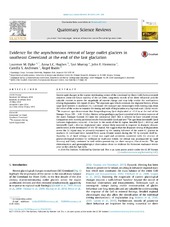| dc.contributor.author | Dyke, Laurence M. | eng |
| dc.contributor.author | Hughes, Anna L.C. | eng |
| dc.contributor.author | Murray, Tavi | eng |
| dc.contributor.author | Hiemstra, John F. | eng |
| dc.contributor.author | Andresen, Camilla S. | eng |
| dc.contributor.author | Rodés, Ángel | eng |
| dc.date.accessioned | 2015-03-17T14:02:36Z | |
| dc.date.available | 2015-03-17T14:02:36Z | |
| dc.date.issued | 2014-09-01 | eng |
| dc.identifier.issn | 0277-3791 | en_US |
| dc.identifier.uri | https://hdl.handle.net/1956/9557 | |
| dc.description.abstract | Recent rapid changes in the marine-terminating sectors of the Greenland Ice Sheet (GrIS) have prompted concerns about the future stability of the ice sheet. Long-term records of ice sheet behaviour provide valuable context to assess the magnitude of current change and may help resolve the mechanisms driving deglaciation. We report 23 new 10Be exposure ages which constrain the deglacial history of two large fjord systems in southeast (SE) Greenland. We compare our chronologies with existing data from the centre of the sector to examine the timing and style of deglaciation at a regional-scale. Glacial erratic 10Be exposure ages demonstrate that Kangerdlugssuaq Fjord deglaciated at ∼11.8 ka at the end of the Younger Dryas (YD – 12.8–11.6 ka). Retreat at Kangerdlugssuaq Fjord coincided with known incursion of the warm Irminger Current (IC) onto the continental shelf; this is inferred to have initiated retreat. Comparison with recently published results from Sermilik Fjord and new 10Be ages from Bernstorffs Fjord indicates deglaciation occurred ∼1 ka later in the south of the SE region. Sermilik Fjord (∼10.9 ka) and Bernstorffs Fjord (∼10.4 ka) deglaciated later; retreat likely occurred in response to dramatic climatic amelioration at the termination of the YD stadial. We suggest that the disparate timing of deglaciation across the SE region may be primarily explained by the varying influence of the warm IC; glaciers in southern SE Greenland were isolated from warm Atlantic waters during the YD by complex shelf bathymetry. In all fjord settings ice retreat was rapid and persistent, consistent with the absence of geomorphological evidence for stillstand or readvance events. Ice retreat was accompanied by rapid thinning and likely continued to well within present-day ice sheet margins. Glacial erratic 10Be age determinations and geomorphological observations show no evidence for Holocene readvance events prior to the Little Ice Age (LIA). | en_US |
| dc.language.iso | eng | eng |
| dc.publisher | Elsevier | en_US |
| dc.rights | Attribution CC BY | eng |
| dc.rights.uri | http://creativecommons.org/licenses/by/3.0/ | eng |
| dc.subject | Greenland Ice Sheet | eng |
| dc.subject | Southeast Greenland | eng |
| dc.subject | 10Be exposure dating | eng |
| dc.subject | Fjord deglaciation | eng |
| dc.title | Evidence for the asynchronous retreat of large outlet glaciers in southeast Greenland at the end of the last glaciation | en_US |
| dc.type | Journal article | |
| dc.date.updated | 2015-03-04T10:09:39Z | en_US |
| dc.description.version | publishedVersion | en_US |
| dc.rights.holder | Copyright 2014 The Authors. Published by Elsevier Ltd. This is an open access article under the CC BY license ( //creativecommons.org/licenses/by/3.0/ ). | en_US |
| dc.identifier.doi | https://doi.org/10.1016/j.quascirev.2014.06.001 | |
| dc.identifier.cristin | 1144107 | |
| dc.source.journal | Quaternary Science Reviews | |
| dc.source.40 | 99 | |
| dc.source.pagenumber | 244-259 | |
| dc.subject.nsi | VDP::Mathematics and natural scienses: 400::Geosciences: 450::Quaternary geology, glaciology: 465 | en_US |
| dc.subject.nsi | VDP::Matematikk og naturvitenskap: 400::Geofag: 450::Kvartærgeologi, glasiologi: 465 | nob |

